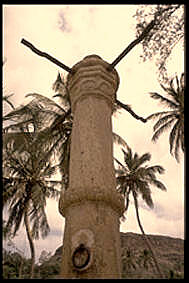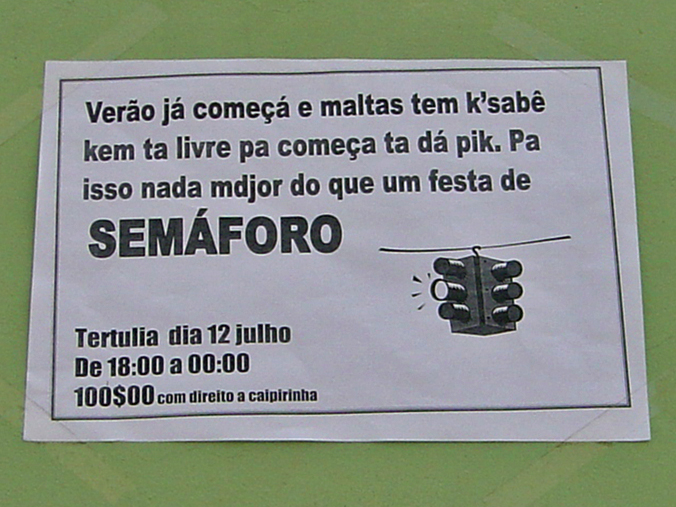|
Tomé Varela Da Silva
Tomé Varela da Silva (born 1948 in São Jorge dos Órgãos, Santiago, Cape Verde) is a Cape Verdean writer, poet, philosopher and anthropologist which he studies in an orally tradition and the musical heritage of Cape Verde in which he favored for the usage of Cape Verdean Creole Cape Verdean Creole is a Portuguese-based creole languages, Portuguese-based creole language spoken on the islands of Cape Verde. It is the native creole language of virtually all Cape Verdeans and is used as a second language by the Cape Verd ... in literature. Himself, he is the author of several poets and stories. His most important works were published in the 1980s and the 1990s He was interviewed along with Corsino Fortes on December 3, 2008 in Nós Fora dos Eixos. He was interviewed again this time with a newspaper '' Expresso das Ilhas'' on the alphabet in Cape Verdean Creole Works * ''Na Bóka Noti'' (2008) - 3 volumes with history Poems * "Ter uma, Ter várias" [...More Info...] [...Related Items...] OR: [Wikipedia] [Google] [Baidu] |
São Jorge Dos Órgãos
SAO or Sao may refer to: Places * Sao civilisation, in Middle Africa from 6th century BC to 16th century AD * Sao, a town in Boussé Department, Burkina Faso * Serb Autonomous Regions (''Srpska autonomna oblast'', SAO), during the breakup of Yugoslavia Science and technology * Smithsonian Astrophysical Observatory of the Smithsonian Institution in Cambridge, Massachusetts, U.S. ** Smithsonian Astrophysical Observatory Star Catalog, which assigns SAO catalogue entries * Special Astrophysical Observatory of the Russian Academy of Science (SAO RAS) * Session-At-Once, a recording mode for optical discs Transportation * Saco Transportation Center, a train station in Saco, Maine, U.S., station code SAO * Sahel Aviation Service, Mali, ICAO airline code SAO * Airports in Greater São Paulo, Brazil, IATA airport code SAO People * Ligi Sao (born 1992), a Samoan rugby league player * Ron Sao, Western Australian politician Other uses * Sao (moon), a satellite of Neptune * Sao ... [...More Info...] [...Related Items...] OR: [Wikipedia] [Google] [Baidu] |
Santiago, Cape Verde
Santiago (Portuguese language, Portuguese for “James, son of Zebedee, Saint James”) is the largest island of Cape Verde, its most important agricultural centre and home to half the nation's population. Part of the Sotavento Islands, it lies between the islands of Maio, Cape Verde, Maio ( to the east) and Fogo, Cape Verde, Fogo ( to the west). It was the first of the islands to be settled: the town of Ribeira Grande (now Cidade Velha and a UNESCO World Heritage Site) was founded in 1462. Santiago is home to the nation's capital city of Praia. History The eastern side of the nearby island of Fogo, Cape Verde, Fogo collapsed into the ocean 73,000 years ago, creating a tsunami high which struck Santiago. In 1460, António de Noli became the first to visit the island. Da Noli settled at ''Ribeira Grande'' (now Cidade Velha) with his family members and Portuguese from Algarve and Alentejo in 1462. [...More Info...] [...Related Items...] OR: [Wikipedia] [Google] [Baidu] |
Cape Verdean Creole
Cape Verdean Creole is a Portuguese-based creole languages, Portuguese-based creole language spoken on the islands of Cape Verde. It is the native creole language of virtually all Cape Verdeans and is used as a second language by the Cape Verdean diaspora. The creole has particular importance for creolistics studies since it is the oldest living creole. It is the most widely spoken Portuguese-based creole language. The full, formal name is Cape Verdean Creole (), but in everyday usage the creole is simply called "Creole" () by its speakers. Origins The history of Cape Verdean Creole is hard to trace due to a lack of written documentation and to ostracism during the Portuguese administration of Cape Verde. There are presently three theories about the formation of Cape Verdean Creole. The monogenetic theory of pidgins, monogenetic theory claims that the creole was formed by the Portuguese by simplifying the Portuguese language in order to make it accessible to enslaved Afr ... [...More Info...] [...Related Items...] OR: [Wikipedia] [Google] [Baidu] |
Corsino Fortes
Corsino António Fortes (14 February 1933 – 24 July 2015) was a Cape Verdean writer, poet and diplomat. He served as the first Ambassador of Cape Verde to Portugal from 1975 until 1981 following his country's independence. Biography Fortes was born in Mindelo on Cape Verde's São Vicente island in 1933. He is a graduate in law of the University of Lisbon (1966), chaired the ''Association of Cape Verde Writers'' (2003-2006) and is the author of some of the most significant works of Cape Verdean literature. He has worked as a teacher and a lawyer and he served as Cape Verde's ambassador to Portugal. He was a judge in Angola in the capital Luanda and Benguela and joined several governments in the Cape Verde Republic. He represented the PAICV. Corsino Fortes's first book ''Pão & Fonema'' (Bread & Phoneme), which appeared in 1974, made an immediate impact. 1974 was a momentous year for Portugal and its African colonies as it was the year in which the authoritarian Estado No ... [...More Info...] [...Related Items...] OR: [Wikipedia] [Google] [Baidu] |
Expresso Das Ilhas
''Expresso das Ilhas'' ( Portuguese for "The Islands' Express") is a weekly Cape Verdean newspaper that covers its top stories in the archipelago and local stories from each island. The newspaper is located in the Cape Verdean capital city of Praia and has one of the largest circulations in Cape Verde. The newspaper is published in Portuguese, apart from some occasional articles in Cape Verdean Creole Cape Verdean Creole is a Portuguese-based creole languages, Portuguese-based creole language spoken on the islands of Cape Verde. It is the native creole language of virtually all Cape Verdeans and is used as a second language by the Cape Verd .... Its current editor-in-chief is João Augusto do Rosário.' Its daily circulation are around 10,000, it costs 100 per copy as of 2010. The newspaper is also available on the Internet. Description The newspaper is close to the Movement for Democracy (MPD) political party. The logo of the newspaper features a navy and light blue wave o ... [...More Info...] [...Related Items...] OR: [Wikipedia] [Google] [Baidu] |
Eugénio Tavares
Eugénio de Paula Tavares (born 18 October 1867 in the island of Brava; died 1 June 1930 in Vila Nova Sintra) was a Cape Verdean poet. He is known through his famous poems ('' mornas''), mostly written in the Creole of Brava. Biography Eugénio de Paula Tavares was born on the island of Brava in October 1867 to Francisco de Paula Tavares and Eugénia Roiz Nozzolini Tavares. His family is mainly descended from Santarém, Portugal. He was baptized at the Saint John the Baptist (São João Baptista) church in Brava. A few years later, his father starved to death and he was adopted by José anEugénia Martins de Vera Cruz. José Martins de Vera Cruz, a physician and surgeon who was also mayor of Boa Vista and Sal (Sal was not its own municipality until the 1930s) and later of Brava after he moved. One of his distant relatives João José de Sena was mayor of the island. In 1876, he attended Nova Sintra's primary school (''Escola Primária''). Most of his times, he never atten ... [...More Info...] [...Related Items...] OR: [Wikipedia] [Google] [Baidu] |
Manuel Veiga (writer)
Manuel Veiga (born 27 March 1948) is a Cape Verdean writer, a linguist with references in the national and international level and a politician. He was minister of culture of his country from 2004 to 2011. As a specialist he did the largest studies and works of appreciation of the Cape Verdean Creole, an Upper Guinean form of Portuguese Creole. He was born in Santa Catarina on the island of Santiago. Life and career His first primary school studies was in the municipal seat of his birthplace, Assomada from 1957 to 1961. He frequently attended the Catholic seminary of S. José (St. Joseph) in the city of Praia, capital of Cape Verde (then provincial) between 1962 and 1974. He studied at Instituto Superior de Estudos Teológicos (Higher Institute of Theological Studies) in Coimbra, Portugal between 1971 and 1974. He had received a degree in general linguistics and applied to the University of Aix-en-Provence in southern France between 1975 and 1978, he returned again same u ... [...More Info...] [...Related Items...] OR: [Wikipedia] [Google] [Baidu] |
1950 Births
Events January * January 1 – The International Police Association (IPA) – the largest police organization in the world – is formed. * January 5 – 1950 Sverdlovsk plane crash, Sverdlovsk plane crash: ''Aeroflot'' Lisunov Li-2 crashes in a snowstorm. All 19 aboard are killed, including almost the entire national ice hockey team (VVS Moscow) of the Soviet Air Force – 11 players, as well as a team doctor and a masseur. * January 6 – The UK recognizes the People's Republic of China; the Republic of China severs diplomatic relations with Britain in response. * January 7 – A fire in the St Elizabeth's Ward of Mercy Hospital in Davenport, Iowa, United States, kills 41 patients. * January 9 – The Israeli government recognizes the People's Republic of China. * January 12 – Submarine collides with Sweden, Swedish oil tanker ''Divina'' in the Thames Estuary and sinks; 64 die. * January 13 – Finland forms diplomatic relations with the People's Republic of Chin ... [...More Info...] [...Related Items...] OR: [Wikipedia] [Google] [Baidu] |
Living People
Purpose: Because living persons may suffer personal harm from inappropriate information, we should watch their articles carefully. By adding an article to this category, it marks them with a notice about sources whenever someone tries to edit them, to remind them of WP:BLP (biographies of living persons) policy that these articles must maintain a neutral point of view, maintain factual accuracy, and be properly sourced. Recent changes to these articles are listed on Special:RecentChangesLinked/Living people. Organization: This category should not be sub-categorized. Entries are generally sorted by family name In many societies, a surname, family name, or last name is the mostly hereditary portion of one's personal name that indicates one's family. It is typically combined with a given name to form the full name of a person, although several give .... Maintenance: Individuals of advanced age (over 90), for whom there has been no new documentation in the last ten ... [...More Info...] [...Related Items...] OR: [Wikipedia] [Google] [Baidu] |
Cape Verdean Male Writers
A cape is a clothing accessory or a sleeveless outer garment of any length that hangs loosely and connects either at the neck or shoulders. They usually cover the back, shoulders, and arms. They come in a variety of styles and have been used throughout history for many different reasons. Semantic distinction In fashion, the word "cape" usually refers to a shorter garment and "cloak" to a full-length version of the different types of garment, though the two terms are sometimes used synonymously for full-length coverings. A shoulder cape is thus sometimes called a "capelet". The fashion cape does not cover the front to any appreciable degree. In raingear, a cape is usually a long and roomy protective garment worn to keep one dry in the rain. History The first known usage of capes is unknown, but some early references we know of are from Ancient Roman military uniforms. Later on, capes were common in medieval Europe, especially when combined with a hood in the chaperon. They ... [...More Info...] [...Related Items...] OR: [Wikipedia] [Google] [Baidu] |



